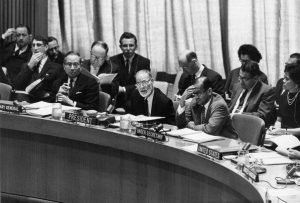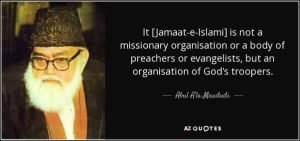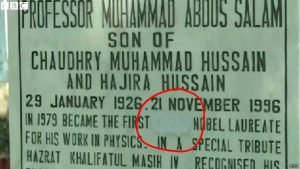Why India must not have any sympathy for Ahmadiyyas?


You may find it difficult to believe this, but it was an Ahmadi who was the real brain behind creation of Pakistan: Sir Muhammad Zafarullah Khan. He was one of the top political intellectuals of undivided India, who is often said to be at par with Ambedkar. Yet he committed the grave mistake of leading his people away from the secular India to Pakistan. The evidence comes from the British archives, quoted by Khan Wali Khan (the son of Badshah Khan) in his book Facts are Facts.

Photo: Sir Muhammad Zafrulla Khan, (center) was the President of the UNGA (17th session). He also served as a judge in International Court of Justice, the Hague, the only Pakistani ever to reach such heights. After the Lahore anti-Ahmadi riots of 1953 he and many other Ahmadis were forced to leave Pakistan.
The Intellectual Father of Pakistan.
It was March 1940. The world War II had just begun. Gandhi and Congress were against India joining the war but Muslim League agreed to cooperate the British if they could get Pakistan after the War. But the proposal submitted by Jinnah and others were not practical. So the Viceroy Lord Lithinglow sought the help of Zafarullah Khan who prepared a draft proposal for dividing India and forming Pakistan.
The Viceroy wrote,
“Upon my instruction Zafarullah wrote a memorandum on the subject. Two Dominion States. I have already sent it to your attention. I have also asked him for further clarification, which, he says, is forthcoming. He is anxious, however, that no one should find out that he has prepared this plan. He has, however, given me the right to do with it what I like, including sending a copy to you. Copies have been passed on to Jinnah, and, I think, to Sir Akbar Hydari. While he, Zafarullah, cannot admit its authorship, his document has been prepared for adoption by the Muslim League, with a view to giving it the fullest publicity.”
Ref.[ Abdul Wali Khan] Facts Are Facts
Thus if it is got leaked out to Sunni Muslims that an Ahmadi had been the architect of the state of Pakistan they might resent it. So the well meaning Zafarullah kept his role a secret.
Now, what do you say about such a person, who, despite knowing that his own people were sure to be second or third class citizens in Pakistan, still opted for it? Shouldn’t he have been the first person to prevent creation of Pakistan?
In the newly independent Pakistan, Ahmadis were the most qualified. Naturally they secured top jobs in most professions, whether in administration, politics and academics. Zafarullah Khan himself became Pakistan’s first foreign minister. Ahmadis’ strength was education; unlike Sunnis they were not jagirdars (feudal landlords) or fighters but intellectuals.
The intellectual domination of Ahmadis was resented by the majority Sunni Muslims, whose strength was in traditional occupations such as landholding, agriculture, military and business. They considered themselves the heirs of Islam and Pakistan, and did not want to be administered by a heretical minority sect. This resentment was the beginning of the tragedy of Ahmadis,, and in the long term, Pakistan itself.
Maulana Maududi and his “God’s Troopers”

The Sunni lobby used the powerful Jama-at Islami headed by the fundamentalist preacher Abul Ala Maududi. His powerful writings were primed against Ahmadis. In 1953 Jama at-Islami launched a well-orchestrated “holy terror” massacring Ahmadis and destroying their businesses. The civilian government did not act. The majority got what they wanted — getting rid of Ahmadi intellectuals and professionals.
Ahmadis who had the wherewithal flee abroad did so, where they did very well. The less fortunate found themselves pariahs in their own country. The following year’s judicial enquiry report headed by Justice Munir ended in a despairing note that hinted on the inevitable path of religious populism that Pakistan had clearly taken.
Justice Munir Commission (1954) Report on 1953 Lahore Riots. (PDF)
But even Justice Munir dared not criticize the real source of the problem — the piously inflammatory writings of Maulana Maududi. His theological influence is still the biggest block to the emancipation of Pakistan. Even the country’s bravest social reformers such as Prof. Parvez Hoodbhoy—cannot criticize its Islamic ideology openly.
Brain-drain Continues…
In that atmosphere of hate Zafarullah Khan had no option but to resign as Foreign Minister of Pakistan. He emigrated to the West in bitterness (and presumably guilt for inadvertently trapping his own people), but then went on to be an internationally acclaimed celebrity. Back home, the state altered its school curricula to expunge Zafarullah Khan’s name from textbooks. I doubt whether the average educated Pakistani knows about Sir Zafarullah Khan and his role as the intellectual father of Pakistan, or his subsequent illustrious international career.
Throughout the 1950s, 1960s and 1970s, persecutions against Pakistani Ahmadis continued sporadically. Some were sensible enough to return to India before the borders got closed (post 1965 war), and the really lucky ones escaped to Europe and US., thus causing Pakistan a severe brain drain. But the anti-Ahmadi and anti-minority sentiments, and racism, kept growing. This was what eventually broke Pakistan into two 1971.
1974. The Most Unkindest Cut of All.
Instead of learning from that breakup, Pakistan kept going in its original direction of intolerance. In 1974, the Pakistani constitution was amended to excommunicate Ahmadis from Islam. Paradoxically this was done by the otherwise secular and socialist Z. A. Bhutto. An astute politician, he realized that religious Islam was about to dominate Pakistan, bowed to the wishes of Jama-at-Islami. (Dawn article: The 1974 ouster of the ‘heretics’: What really happened?). Ahmadi passports no longer mentioned they were Muslim, which also meant they would not be admitted in Mecca or allowed to preform Hajj. They were officially apostates so according to Sharia law, and thus fair game.
Ahmadis who opted to remain in Pakistan were severely mistreated, sometimes killed, their mosques and properties destroyed. Pakistan also officially insulted their only Nobel Laureate Abdus Salam (Winner of Nobel Prize in Physics 1979) both in life and death. He became an insult to “Pakistaniat”. His own university had no option but to downplay his achievements and his public lectures were boycotted by the elite and threatened by crowds. His grave, still in Pakistan, was forcibly erased of the words that mentioned he was a Muslim. So even dead Ahmadis had no peace in Pakistan.

To summarize the answer to your question, the creation of Pakistan owed in great part to an Ahmadi Muslim who believed in the unity of all Muslims. Though people make great mistakes, but this one was a whopper, which must never be forgotten by India and Indians!
About Ahmadi Islam
Theologically there is very little difference between Ahmadiyya and mainstream Muslim (Sunni) faiths. Both follow the same Quran, follow all the five pillars of Islam.
The difference is that Ahmadiyyas believe in a non-literal interpretation of Quran as given by their imam whom the believe to be the Promised Messiah for the world. They claim to be one of the most peaceful and progressive sects of Islam.
Hence we must not be moved by reports of Ahmadies being killed on daily bases, with newspapers publishing their killing in reference to the religion. They played a very important role in the making of Pakistan and then establishing it. Many renowned names can be cited who served Pakistan, in army, finance, science and many other departments. Ahmadies were amongst the very few religious groups who favored Pakistan and Muhammad Ali Jinnah at the time of establishment of Pakistan. Most of the other religious sects and their figures, favoured, in fact, Indian Congress at that time.
DISCLAIMER: The author is solely responsible for the views expressed in this article. The author carries the responsibility for citing and/or licensing of images utilized within the text.
